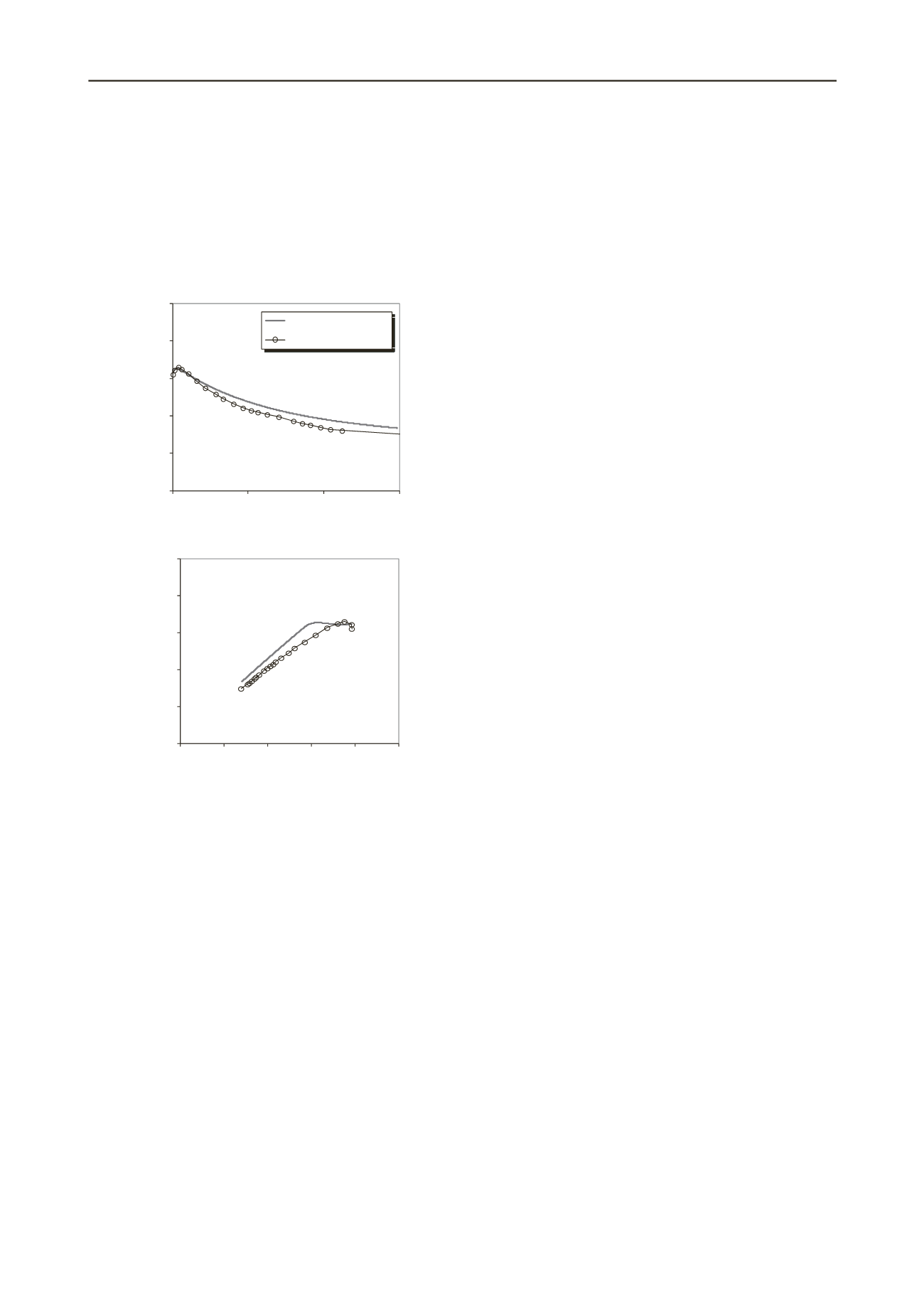
836
Proceedings of the 18
th
International Conference on Soil Mechanics and Geotechnical Engineering, Paris 2013
strain test U05 is shown in Figure 4 with both the stress-strain
and effective stress-paths being shown. The initial stress state
was rather close to the instability limit so that only a small
increase in the deviatoric stress caused a transition into a static
liquefaction situation.
A rather good fit between the measured and computed
stress-strain behaviour is evident on Figure 4 with the brittle
strength loss being closely modelled. However, a small offset is
apparent in the fully-liquefied strength.
0
50
100
150
200
250
0
5
10
15
Deviatoric stress invariant, q ( kPa)
Major principal strain,
1
(%)
NorSand (PS)
Changi Sand PS-U05
0
50
100
150
200
250
0
50
100
150
200
250
Deviatoric stress invariant, q (kPa)
Mean effective stress, p' (kPa)
Figure 4. NorSand simulation of loose Changi sand in plane strain.
The match of simulation to measured behaviour of Changi
sand is not as good for the stress-path (Figure 4). The sand
shows instability at a lower slope to the instability line than the
simulation, although the peak undrained strength itself is very
closely predicted. This mismatch of the stress-path may seem
surprising given the good fit to the stress-strain response, but in
fact the mismatch in the stress-path all develops in the initial
0.2% of so of
1
and that is not readily seen in Figure 4. There
are a range of possible issues when considering the mismatch
between NorSand and measured data: broadly, there are
potentially both experimental and/or theoretical errors.
In the case of test errors, there could be differences between the
reported and actual sample void ratio, over-idealization in the
CSL, or indeed inaccuracies in the stress sensors themselves
(for
2
in particular).
Regarding theoretical errors, there are two areas for
concern: stress-dilatancy and work-hardening. Stress-dilatancy
follows in part from the Second Law of thermodynamics and
would seem robust, but there are legitimate concerns about the
coefficient M. NorSand includes both an idealization for how M
varies with
2
(i.e. Lode angle) as well as a particular
idealization for the evolution of M with state parameter (i.e.
strain). Both idealizations are open to refinement. However, it
is thought that the more likely case of the mismatch between
computed and measured stress-paths lies in the hardening law as
it is this hardening limit that actually controls the slope of the
instability line. NorSand presently projects the hardening limits
seen in dense samples linearly to loose states; further
investigation of hardening limits for both loose states and plane
strain conditions is warranted.
4 CONCLUSIONS
Despite plane strain being widely accepted as a good analogy
for many field slope failures, plane strain remains a relatively
unusual test condition. Undrained plane stain testing that
replicates liquefaction is even rarer, and provided an
opportunity to assess the ability of a “good” mechanics based
model (i.e. one whose properties are invariant with stress level
and void ratio), to predict the behaviour of very loose undrained
plane strain tests. The selected constitutive model, NorSand,
was calibrated to standard triaxial tests that are similar to those
available from commercial testing laboratories.
The match between the plane strain experimental and
predicted NorSand response matches rather well, providing
confidence in this mechanics-based methodology. What is
intriguing is that this match has been achieved with very simple
idealizations of the underlying physics of soil behaviour.
5 REFERENCES
Chu J. and Leong W.K. 2001. Pre-failure strain softening and prefailure
instability of sand: a comparative study.
Géotechnique
51(4), 311-
321.
Chu J., Leroueil, S. and Leong W.K. 2003. Unstable behaviour of sand
and its implication for slope stability.
Canadian Geotechnical
Journal
40(5), 873-885.
Fourie A.B., Blight G.E. and Papageorgiou G. 2001. Static liquefaction
as a possible explanation for the Merriespruit tailings dam failure.
Canadian Geotechnical Journal
38(4), 707-719.
Jefferies M. G. 1993. Nor-Sand: a simple critical state model for sand
Géotechnique
43(1), 91-103.
Jefferies M. and Been K. 2000.
Soil Liquefaction: A critical state
approach
. Taylor and Francis.
Jefferies M.G. and Shuttle D.A. 2002. Dilatancy in general Cambridge-
type models.
Géotechnique
52(9), 625-638.
Jefferies M.G. and Shuttle D.A. 2005. NorSand: Features, calibration
and use. In
Geotechnical Special Publication No. 128, Soil
Constitutive Models: Evaluation, Selection, and Calibration
, J.A.
Yamamuro and V.N. Kaliakin (Eds), ASCE, pp 204-236.
Lade P.V. 1993. Initiation of static instability in the submarine Nerlerk
Berm.
Canadian Geotechnical Journal
30(6), 895-904.
Poulos S.J., Castro G. and France J.W. 1985. Liquefaction evaluation
procedure. Journal of Geotechical Engineering 111(6), 772-791.
Rowe P.W. and Barden L. 1964. Importance of free ends in triaxial
testing.
Journal of Soil Mechanics and Foundations Division
90(1),
1-15.
Schofield A.N. and Wroth C.P 1968.
Critical State Soil Mechanics
,
McGraw-Hill.
Shuttle D.A. and Jefferies M.G. 2012. NorSand implementation for
FLAC; Submitted for publication in
Geotechnique Letters
; an
extended version is available for download from
/.
Wanatowski D. and Chu J. 2006. Stress-strain behavior of a granular fill
measured by a new plane-strain apparatus,
Geotechnical Testing
Journal
29(2), 149-157.
Wanatowski D. and Chu J. 2007. Static liquefaction of sand in plane
strain.
Canadian Geotechnical Journal
44(3), 299-313.
Wanatowski D. and Chu J. 2008. Undrained behaviour of Changi sand
in triaxial and plane-strain compression,
Geomechanics and
Geoengineerin
g 3(2), 85-96.
Wanatowski D. and Chu J. 2012. Factors affecting pre-failure instability
of sand under plane-strain conditions,
Géotechnique
, 62(2), 121-
135.
Youd T., Idriss I., Andrus R., Arango I., Castro G., Christian J., Dobry
R., Finn W., Harder L., Hynes M., Ishihara K., Koester J., Liao S.,
Marcuson W., Martin G., Mitchell J., Moriwaki Y., Power M.,
Robertson P., Seed R., and Stokoe K. 2001. Liquefaction
Resistance of Soils: Summary Report from the 1996 NCEER and
1998 NCEER/NSF Workshops on Evaluation of Liquefaction
Resistance of Soils.
Journal of Geotechnical and Geoenvironmental
Engineering
127(10), 817-833.


